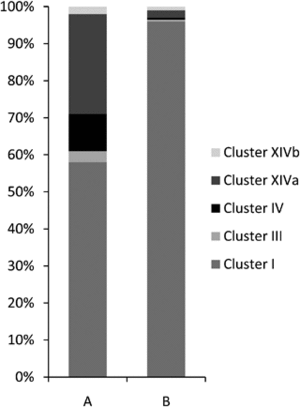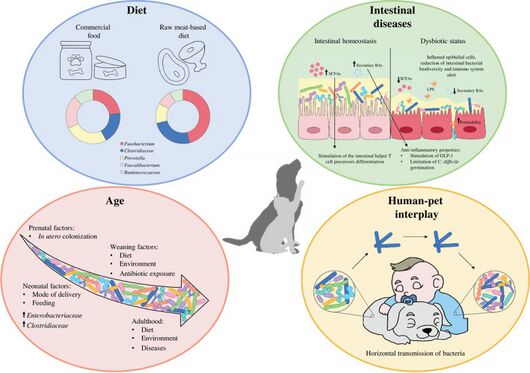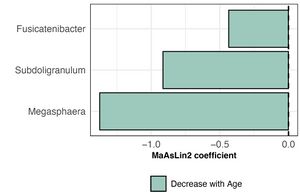Domestic cat intestinal microbiome
Introduction
By Xinyi Liu

Cats have been domesticated for a long time, becoming cherished companions for humans. Similar to humans, they are colonized by bacteria during birth. When kittens are born, they are exposed to the external environment, leading to changes in their gut microbiota. After weaning, felines consume high-protein foods in large quantities, causing significant changes in the species composition and structure of their gut microbiota.The differing diets of humans and felines contribute to significant variations in the composition of their intestinal microbiota.[1] The domestic cat, being an obligate carnivore, depends on protein-rich animal tissues to fulfill its distinct nutritional needs. It is metabolically adapted for lower glucose utilization and higher protein metabolism. As a result, its gut flora composition is relatively straightforward and does not heavily rely on microbiota to regulate energy balance, unlike omnivorous humans.[2] However, these gut microbes still play crucial roles in the immune and digestive systems of felines. Given their prolonged coexistence with humans, the condition of domestic pet cats' gut microbiota can impact not only their own health but also that of their owners.[3]
Composition of domestic cat intestinal microbiome

The cat's gastrointestinal tract harbors a complex ecosystem comprising various microorganisms, including bacteria, viruses, fungi, and protozoa. Among these, bacteria constitute over 98% of the population, and predominantly strict and facultative anaerobic bacteria dominate the gut microbiota. [4]Their metabolic activities generate beneficial molecules like food or drug compounds, enhancing the host's immune response and metabolic capabilities. These intestinal bacteria play a crucial role in regulating the immune system, defending against external pathogens, and supplying essential nutrients, such as vitamins that may be scarce or challenging for the host to produce independently. Gut bacteria in cats play a crucial role not only in digestive diseases like inflammatory bowel disease or alimentary small cell lymphoma but also in the overall well-being of an organism.[5] While the precise mechanisms are still under investigation, it's clear that gut bacteria can impact a wide range of diseases affecting various organs and systems, including but not limited to diabetes, chronic kidney disease, and obesity.[6][7][8]

In the gastrointestinal tract of normal, healthy domestic cats, there are five major bacterial phyla present. These are predominantly classified as Firmicutes (68%), followed by Proteobacteria (14%), Bacteroidetes (10%), Fusobacteria (5%), and Actinobacteria (4%). Within the Firmicutes phylum, the majority of bacteria belong to the orders Clostridiales (54%), followed by Lactobacillales (14%), Bacteroidales (11%), Campylobacterales (10%), and Fusoacteriales (6%). Specifically, within the Clostridiales order, the predominant domains are Clostridium clusters I (58%) and XIVa (27%).The intestinal microbiota of the healthy specific pathogen-free cat showed a decreased bacterial diversity when compared to normal raised domestic cat, with 98% of all bacterial classified within the phylum Firmicutes.[9]

Approximately four-fifths of all bacteria found were classified as Firmicutes, exhibiting diverse representation across various Clostridium clusters within the Clostridiales class. These bacteria were affiliated with six different Clostridium clusters: clusters I, III, IV, XI, XIVa, and XIVb. Roughly half of these Firmicutes were found in the jejunum, with slightly fewer in the colon, and the rest in the ileum..[9]
Actinobacteria distribution was fairly evenly split, with approximately one-third found in the ileum, another third in the colon, and the remaining third in the jejunum..[9]
Regarding Bacteroidetes, about half of them were located in the ileum, with a significant portion in the colon and a smaller proportion in the rectum. The jejunum had only a negligible amount of Bacteroidetes..[9]
The majority of Fusobacteria, roughly two-thirds, were found in the colon, followed by smaller proportions in the jejunum and ileum..[9]
The phylum Proteobacteria showed a varied distribution. Approximately one-third of Proteobacteria clones were found in the duodenum, ileum, and colon each, with smaller proportions in the jejunum and rectum..[9]
In the duodenum of healthy domestic cats, the levels of total bacteria are consistent, with a dominant presence of anaerobic bacteria like Clostridium and Bacteroides, which are known for their ability to deconjugate bile acids and bind cobalamin, essential for digestive health. Domestic cats with clinical symptoms of gastrointestinal issues had lower counts of several bacteria species, including Pasteurella, Bacteroides, and Lactobacillus. Pasteurella are commonly found in the respiratory tract but can also inhabit the gastrointestinal tract. Bacteroides, which plays a crucial role in bile acid metabolism and is associated with steatorrhea, a condition characterized by fat malabsorption. Lactobacillus are beneficial bacteria known for their role in maintaining gut health and aiding in digestion.[10]
Factors influencing the intestinal microbiome of domestic cats

Core Microbiome of Healthy Pet Cats
The core microbiome of a healthy domestic cat includes 30 bacterial genera from five phyla. Among these, Prevotella, Bacteroides, Collinsella, Blautia, and Megasphaera are the most abundant core genera. Bacteroides, Blautia, Lachnoclostridium, Sutterella, and Ruminococcus gnavus are the most common core genera overall.[11]
In healthy cats, Subdoligranulum and Megasphaera are prevalent, with detection rates exceeding half of the individuals in the healthy cats. Conversely, Fusicatenibacter has a very low prevalence in the healthy reference set, detected in only about 15% of healthy cats.[11]
Age

The bacterial community composition in healthy pet cats remained relatively stable across different age groups. Prevotella, Bacteroides, and Fusobacterium were identified as the most abundant bacterial genera in their intestinal tract. Although the total proportion of core taxa in the fecal microbiome remained consistent with age, the actual number of core taxa decreased significantly as a percentage of the total 30 taxa.[11] Additionally, the abundance of these three genera varied across different age groups, with Fusicatenibacter, Subdoligranulum, and Megasphaera showing a decrease in relative abundance as the cats aged.[12]
Diet
Feline Immunodeficiency Virus(FIV) Status
Living Environment
Section 3
Include some current research, with at least one figure showing data.
Section 4
Conclusion
References
- ↑ Lubbs, Dustin C. et al. "Dietary protein concentration affects intestinal microbiota of adult cats: a study using DGGE and qPCR to evaluate differences in microbial populations in the feline gastrointestinal tract.” Journal of animal physiology and animal nutrition 93 1 (2009): 113-21.
- ↑ MacDonald, M L et al. “Nutrition of the domestic cat, a mammalian carnivore.” Annual review of nutrition vol. 4 (1984): 521-62. doi:10.1146/annurev.nu.04.070184.002513
- ↑ Alessandri, Giulia et al. “Catching a glimpse of the bacterial gut community of companion animals: a canine and feline perspective.” Microbial biotechnology vol. 13,6 (2020): 1708-1732. doi:10.1111/1751-7915.13656
- ↑ Lauren E et al. “Assessment of microbial diversity along the feline intestinal tract using 16S rRNA gene analysis.” FEMS microbiology ecology vol. 66,3 (2008): 590-8. doi:10.1111/j.1574-6941.2008.00609.x
- ↑ Ganz, Holly H et al. “The Kitty Microbiome Project: Defining the Healthy Fecal "Core Microbiome" in Pet Domestic Cats.” Veterinary sciences vol. 9,11 635. 16 Nov. 2022, doi:10.3390/vetsci9110635
- ↑ Kieler, Ida Nordang, et al. "Diabetic cats have decreased gut microbial diversity and a lack of butyrate producing bacteria." Scientific reports 9.1 (2019): 4822.
- ↑ Summers, Stacie C et al. “The fecal microbiome and serum concentrations of indoxyl sulfate and p-cresol sulfate in cats with chronic kidney disease.” Journal of veterinary internal medicine vol. 33,2 (2019): 662-669. doi:10.1111/jvim.15389
- ↑ Kieler, I N et al. “Overweight and the feline gut microbiome - a pilot study.” Journal of animal physiology and animal nutrition vol. 100,3 (2016): 478-84. doi:10.1111/jpn.12409
- ↑ 9.0 9.1 9.2 9.3 9.4 9.5 Lauren E et al. “Assessment of microbial diversity along the feline intestinal tract using 16S rRNA gene analysis.” FEMS microbiology ecology vol. 66,3 (2008): 590-8. doi:10.1111/j.1574-6941.2008.00609.x
- ↑ K L et al. “Comparison of the bacterial flora of the duodenum in healthy cats and cats with signs of gastrointestinal tract disease.” Journal of the American Veterinary Medical Association vol. 218,1 (2001): 48-51. doi:10.2460/javma.2001.218.48
- ↑ 11.0 11.1 11.2 11.3 Ganz, Holly H et al. “The Kitty Microbiome Project: Defining the Healthy Fecal "Core Microbiome" in Pet Domestic Cats.” Veterinary sciences vol. 9,11 635. 16 Nov. 2022, doi:10.3390/vetsci9110635
- ↑ Deusch, Oliver, et al. "A longitudinal study of the feline faecal microbiome identifies changes into early adulthood irrespective of sexual development." PloS one 10.12 (2015): e0144881.
Authored for BIOL 238 Microbiology, taught by Joan Slonczewski,at Kenyon College,2024
